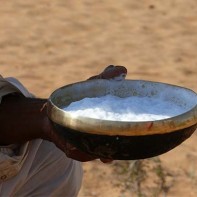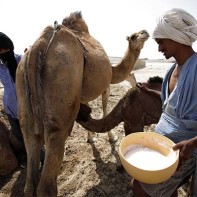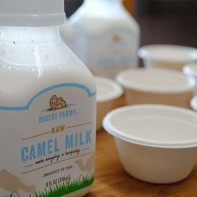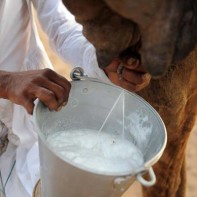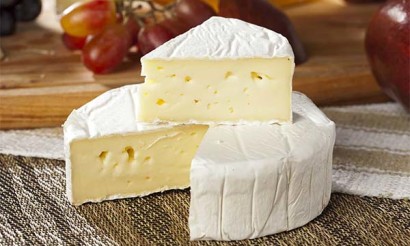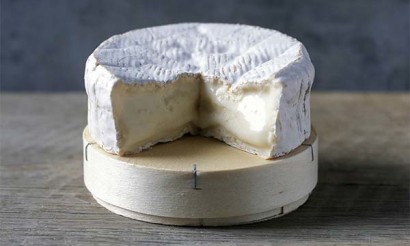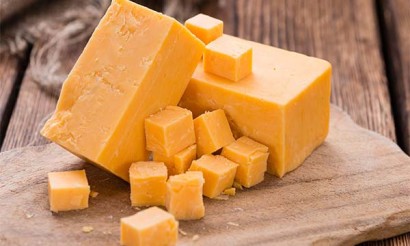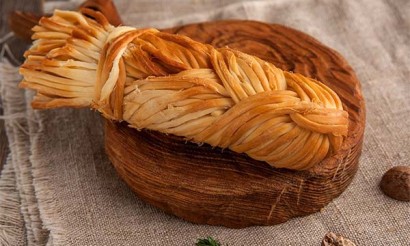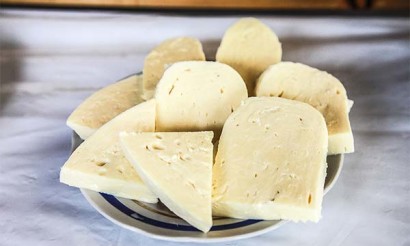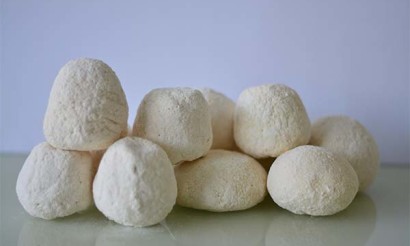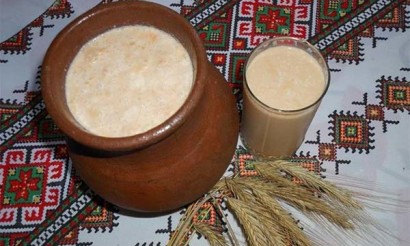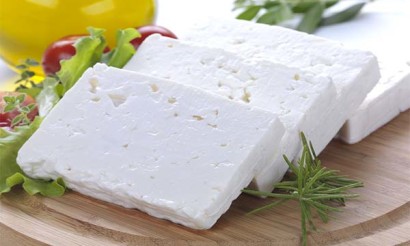Camel milk: useful properties and uses
Camel milk is milk obtained from domestic camels. Production and consumption of this product is more widespread primarily in the desert and arid areas: in particular, representatives of some tribes, preparing from it a kind of yogurt, can eat more than a month this product alone.
- What is this drink
- What it tastes like
- What's the fat content
- How it differs from cow's milk
- Composition and calories
- What is camel milk good for the body
- For women
- For pregnant women
- For men
- For children
- For what diseases is used
- Cancer and leukemia
- Chronic gastritis
- Diabetes mellitus
- Psoriasis
- Autism
- Allergies
- Immunity strengthening
- Can I drink camel milk while losing weight?
- Harm and contraindications
- Cosmetic use
- How to use camel milk correctly
- Culinary applications
- How to choose and store
- Can it be frozen?
- Where to buy it and how much does it cost?
- Camel milk cheeses
- Nabulsi
- Akkavi
- Caravan
- Kapchgul
- Camel milk chocolate
- Al Nassma
- Nouq
- Kamelka
- aAdvik
- What can be made with camel milk
- Shubat
- Pie
- Holiday eggnog
- Muffins
- Flourless dough
- Interesting facts about camel milk
- Q&A
- How much milk does a camel give?
- Why doesn't camel milk sour?
- Can camel milk be mixed with alcohol?
- What is cream taken from camel's milk called?
What kind of drink is it?
Camel's milk is a white colored liquid (female secret) that camels secrete after giving birth to feed their baby camels. It is actively used by humans for food, not only in its pure form, but also for making fermented dairy products.
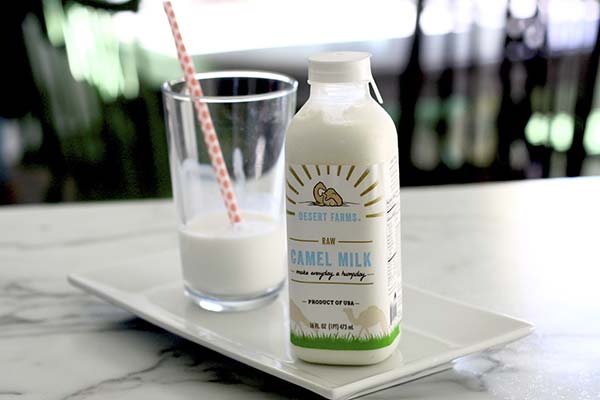
What it tastes like
In appearance and taste, camel milk is almost the same as cow's milk, it is white in color, with a sweet and slightly brackish taste, the intensity of which is determined by the animal's food and water quality. Milk contains quite a large amount of sodium in its composition, so it is very good thirst quencher in the hot conditions of life.
What is the fat content
According to the U.S. Food and Drug Administration (FDA), the fat content of camel milk is 3%.
How it differs from cow's milk
Camel milk is not much different from cow's milk. A slight difference can be seen in the hue. Cow's milk has a yellowish color, while camel's milk is white, like the first untouched snow. That is why it is very difficult to fake it: when diluted with cow's milk, it immediately loses its usefulness and properties and acquires a yellow tint.
Composition and calories
The proportions of proteins and carbohydrates in camel milk are almost similar to those of cow milk, but it contains far fewer calories and saturated fat. A glass of camel's milk is 110 kcal and 4.5 g of fat, while a similar portion of cow's milk has 10 kcal and 8 g of fat.
It may seem surprising, but the chemical composition of camel milk differs significantly from other more familiar varieties of the product. The most noticeable difference is in the structure of proteins. Scientists have counted more than two hundred of them in camel's milk. But camel milk does not contain casein and lactoglobulin, which often cause allergic reactions. To be more precise, camel product does not contain A1 casein, which is usually found in cow's milk and is an allergen, and A2 casein, which is present in goat's product. Instead, camelina milk contains a safer option, A2 beta-casein. In addition, scientists found a group of proteins in this drink that have antiviral, antifungal, and antibacterial properties.
Another significant difference of milk from the desert is its incredibly low fat content. The fat content of a camel's product usually does not exceed 2-3%. In addition, the special structure of the omega-3 fatty acids it contains allows camel milk to be frozen and thawed without changing its consistency, without fear that it will curdle, as often happens with cow's milk.
Numerous studies indicate that camels produce milk that is unique in its composition and structure. Scientists have found in this product a huge amount of immunoglobulins, powerful immunostimulating substances. Interestingly, the immunoglobulins contained in camel milk are noticeably smaller than those contained in the human body. For this reason, immunostimulants from camel product can easily penetrate into the tissues of human bodies. It is these substances that are considered in the scientific world to be an effective defense against autoimmune diseases. And some researchers suggest that immunostimulants from camel product are useful for treating childhood autism. Although it is fair to say that there is no consensus in the scientific community about this yet. Another amazing component of this product is insulin-like substances. And there are many of these components in the milk of camels. That is why it is included in the number of useful for people with diabetes.
As it turns out, camel milk has a higher nutritional value than other types of milk. It is rich in minerals, unsaturated fatty acids, and vitamins. Compared with cow's milk, it contains almost 10 times more iron and about 3 times more ascorbic acid. In addition to these components, camel milk is rich in a complex of vitamins B, A, D, E, K, as well as many minerals.
As a result, comparing the chemical composition and features of camel milk with other dairy products, the researchers concluded that the drink from the desert is more reminiscent of a woman's breast milk than cow's milk. For this reason, it, unlike cow's milk, is much healthier and safer for babies.
Nutritional value per 100 g:
Vitamins:
- A, RE - 40 micrograms;
- B1, thiamine - 0.08 mg;
- B2, riboflavin - 0.02 mg;
- B12, cobalamin - 0.16 µg;
- C, ascorbic - 7.7 mg.
Macronutrients:
- Potassium, 180 mg;
- calcium - 121 mg;
- Sodium - 70 mg.
- trace elements:
- iron - 0.1 mg;
- cobalt - 5 mg;
- zinc - 0.4 mg.
Source: Skurikhin I.M. et al. The chemical composition of food products.
How is camel milk good for the body
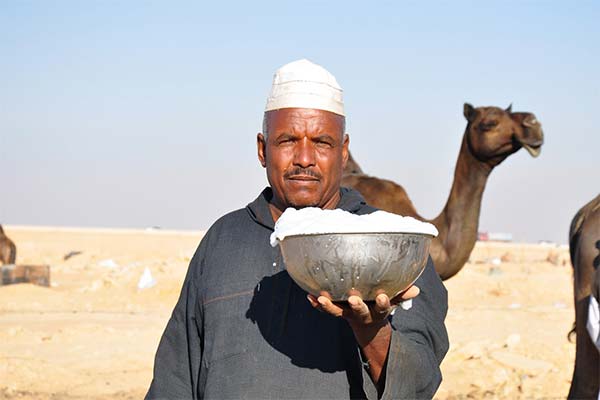
For women
The drink of the Bedouins is useful for the female body. It helps:
- Heal wounds and ulcers on the gastrointestinal mucosa after a diet on citrus fruits.
- Relieve bad moods and even out its fluctuations.
- Take away the unpleasant symptoms of PMS: dizziness, weakness, nervousness.
Important! Women are not recommended to drink camel milk fresh. When it is received, purity is not always observed, so it is very easy to get food poisoning due to pathogenic microflora. Boiling is a must!
For pregnant women
Omega-3 acids in fats protect the baby in your tummy from the sun's radiation and carcinogens that saturate the world around them. Immunoglobulins help maintain the immune system of the woman and the unborn child. There are other benefits of drinking the Bedouin drink during pregnancy:
- There is normal fetal weight gain;
- the pregnant woman does not have anemia, as it contains a lot of iron;
- Stabilizes digestion, acting as a prebiotic;
- protects the nervous system from overloading;
- strengthens the baby's bone system.
When consumed after childbirth, it promotes active lactation: the mother is ready for natural feeding. In addition, breast milk becomes more tasty and nutritious.
For men
Camel milk gives men strength and stamina. It helps:
- Cleanse the liver of the stronger sex, who are more likely to consume junk food and alcohol.
- Inhibit the processes of inflammation in the pelvic area.
- Normalize the level of the male hormone - testosterone.
- Increase the volume of the lungs, which is important for physical activity.
For children.
Camel milk has therapeutic properties for severe food allergies and can restore the immune system in children. These are the conclusions of a small study conducted on eight young patients from 4 months to 10 years, scientists from the Israeli city of Beer Sheva.
In what diseases is it used
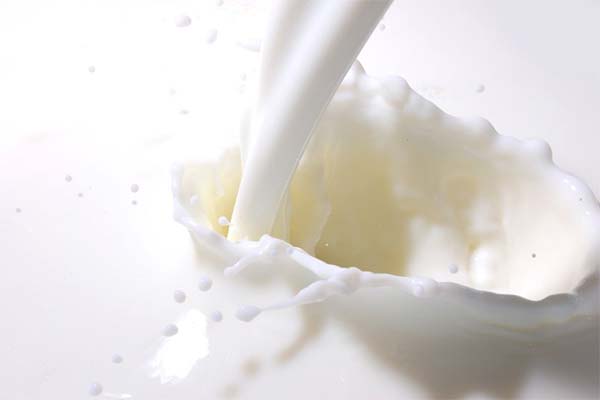
Cancer and leukemia
The use of camel's milk in the treatment of cancer and leukemia has a scientific basis. Experiments were conducted at the University of Sharjah and the Cancer Institute in Baghdad by a team of researchers led by Sabah Jassem.
Studies on the composition of milk have isolated an active substance that cleanses the body of compounds that provoke cancer. The fact is that camels have one of the most perfect immune systems, which fights not only external infectious agents and foreign substances, but also the aggression of the body against itself. The treatment is based on a balanced treatment regimen of proportions of camel's milk and camel's urine. Scientific experiments have shown that camel urine acts as the strongest antibiotic, has a devastating effect on bacteria, viruses and protozoa, which are the causative agents of cancer.
After a laboratory study of the constituents of camel urine, it was found that a liter of urine contains:
- 10 grams of protein;
- 27 grams of nitrogen;
- 7 grams of albumin;
- 10,000 milligrams of urea;
- 29 milligrams of creatine;
- 245 milligrams of uric acid;
- 108 grams of creatinine;
- 248 milligrams of sodium;
- 8,000 milligrams of potassium;
- 12 milligrams of calcium;
- 246 milligrams of magnesium;
- 59 micrograms of copper;
- 58 micrograms of iron;
- 22 micrograms of zinc.
The combined treatment regimen based on camel milk and camel urine is used in Oriental medicine to treat cancer and skin diseases, hepatitis, stomach diseases, tuberculosis, allergic diseases, osteoporosis and other bone diseases, diabetes, allergic diseases, dropsy, liver cirrhosis. And this is not a complete list of human ailments to cure, from which the milk and urine of camels helps cure.
Chronic gastritis
Camel's milk is a unique natural remedy for chronic gastritis, its use helps to stop the inflammatory process in the mucous membrane and normalizes the acidity of gastric juice.
Steamed milk is taken on an empty stomach, 200 ml 30 minutes before a meal (or instead of breakfast, limit the intake of steamed milk), 2-3 times a day. The specified volume of 200 ml is achieved gradually, starting with 50 ml per dose, depending on individual tolerance, over 5-7 days. After 2-3 days, there is an improvement, with good tolerance, the minimum duration of intake of steamed milk - 1 month. The most important condition for the effectiveness of the treatment of gastritis is strict adherence to a sparing diet, with the exception of spicy, fried, salty, fatty, rough (having a mechanical effect on the mucosa of the stomach) products.
Diabetes mellitus.
From research and clinical trials conducted by scientists, it was found that camel's milk contains a significant amount of insulin-like protein, which, unlike artificially synthesized insulin, is not destroyed in the stomach and completely enters the blood creating an anti-diabetic effect in the body. As we know, because of the acidity of the gastric juice, insulin, if taken by mouth, breaks down quickly and does nothing to help the patient. This is why it fails to produce the insulin that people would get as food and not through injections.
Clinical trials on people with type 1 diabetes have shown that daily consumption of 0.5 liters of camel milk reduces the need for insulin-containing medications by an average of 30%. The greatest therapeutic effect is achieved with the combined intake of milk and camel urine. Camel urine significantly lowers patients' sugar levels. Camel milk and urine have been used since ancient times as a medicine for diabetics.
Psoriasis
The unique therapeutic properties of camel's milk are due to the active natural chemical ingredients it contains, such as alpha-hydroxy acids, ascorbic acid, proteins, antioxidants, proteins and immune complexes, vitamins A, B vitamins, carotenes, antibacterial agents.
The natural combination of all of the above and many other natural biologically active components helps to soften and reject psoriatic plaques, relieve inflammation and itching, reduce the proliferative activity of the affected epidermis. Of no small importance in the treatment is the pronounced antibacterial properties of camel's milk.
Autism
Studies have been conducted with active use of camel's milk on people suffering from autism. Drs. Yosef Shabo, Reuven Barzel, Mark Margulis, and veterinarian Reuven Yagil of Maccabi Hospital Services explain in their research that camel milk, being devoid of beta-casein and beta-lactoglobulin, is an essential product for autistic people.
In addition, the immunoglobulins and protective proteins present in it help with brain development. Studies conducted on the effects of camel milk on autistic children of different age groups, the results of the case studies were very conclusive and proved that camel milk actually showed improvement in their communication skills and brain function.
Allergies
Camel milk is hypoallergenic and contains no components that can cause allergies. In severe food allergies, it can restore the immune system in both adults and children. This was the conclusion reached by scientists in Beer Sheva, Israel, as a result of a small study conducted on eight young patients from 4 months to 10 years of age.
The composition of camel milk is very different from that of other ruminants. It consists of completely homogenized, polyunsaturated fatty acids, giving it a uniform white color. Lactose (milk sugar) is present in camel's milk at a concentration of 4.8%, but is easily digested by people with lactose intolerance.
According to researchers, it is the proteins in camel milk that play the most important role in treating food allergies, since it does not contain beta-lactoglobulin and various beta-caseins, the very components of cow's milk that cause allergies. Camel milk is rich in vitamin C, calcium and iron, and contains a number of immunoglobulins (antibodies) that are compatible with human antibodies and micromolecules that can easily enter the blood through the intestinal wall.
Immunity Boosting
Camel milk contains antibodies and immunoglobulins that make the body resistant to a wide range of diseases and invading foreign particles. Consumption of camel's milk on a regular basis greatly increases and strengthens the immune potential of the body.
The main function of immunoglobulins is to protect the body from autoimmune diseases, allergies and certain types of bacterial, fungal and viral infections. Camel's milk can be drunk every day just to increase immunity strength.
Important! The scheme and method of treatment for any disease is determined only by the doctor who is treating you.
Can you drink camel milk to lose weight?
Camel milk helps to lose weight. This was announced by scientists from the Veterinary Research Laboratory at the Dubai Center.
In experiments involving 480 overweight volunteers aged 23 to 45 years, it was found that cow's milk increases weight. And camel milk promotes weight loss and normal distribution of subcutaneous fat.
Harm and contraindications
Proven medicine has not studied camel milk well enough, but in the few studies that have been conducted, it has shown itself only on the positive side. According to practical observations, the drink does not cause much harm, so contraindications are more of a recommendatory nature.
- The fat content of camels' milk is 8%, and those who control the amount of fats in the diet should take it into consideration.
- For a person unaccustomed to the product, its consumption can cause digestive disorders and abdominal pain. You should not drink too much at once.
- It is undesirable to drink camel's milk for people with diseases that, among other things, provoke excess cobalt. These are: neuritis of the auditory nerve, cardiomyopathy, contact dermatitis, increased thyroid gland.
- Beta-casein A2, which is contained in the drink, can also cause allergies, but the reactions are usually less severe. Some people with an intolerance to dairy products will not be able to consume it.
Its use in cosmetology
On the basis of the properties of the product is carried out restoration and rejuvenation of the skin at home. Camel milk for the face is used in the form of masks. In order to prevent the appearance of wrinkles or to give tone to tired skin, it is applied to the cleansed surface of the face, after 5-10 minutes wash off with warm water. To correct age-related changes use the following composition:
- milk product;
- white clay;
- honey;
- rose oil.
It is necessary to mix all the components in equal quantities. Lubricate the surface of the face, and after 10-15 minutes rinse it off. To care for the whole body, make baths and add a few cups of the beneficial drink to the water. Some manufacturers on the basis of camel's milk produce cosmetics. For example, you can often see shampoo with this exotic additive on the shelves.
What is the right way to consume camel milk
Camel's milk in Arab countries, like green tea for the Chinese, is the national traditional drink. They drink it every day: in the morning, at lunchtime, in the evening and also when they just need to quench their thirst or have a quick snack.
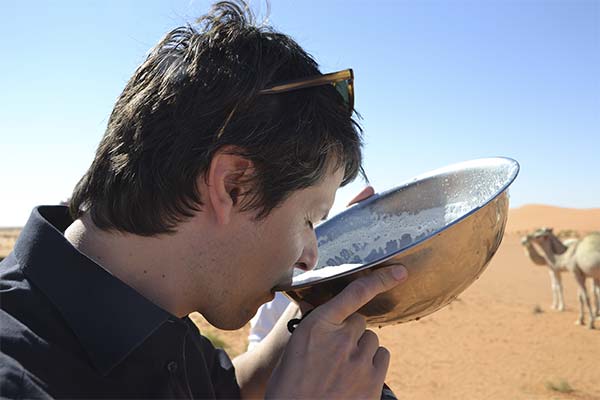
But for the European organism such an amount of drink is unusual and can be harmful. That is why it should be introduced into your diet gradually, starting with just a few sips. If you drink a shocking dose at once, it is likely to cause diarrhea, which, however, in most cases, passes in a couple of days, leaving no consequences.
If you use camel's milk for therapeutic purposes, you should drink it, as medics recommend, about half a liter per day. For the average healthy person, the daily rate can be one to two cups. Milk should not be drunk in one gulp, but a sip, savoring slowly. Then it will be better absorbed. Take a sip, hold it in your mouth, swallow. And drink one glass in fifteen minutes. And then the intestines will be in excellent condition, and all the nutrients will be absorbed.
Cooking Applications
Such a product is widely used in cooking in a variety of recipes. In Eastern countries, camel milk is particularly popular, there are prepared on its basis a variety of drinks and dairy products. The Kazakhs prepare koumiss from this milk. Camel milk is also used in European countries, for example, in Switzerland it is used in chocolate. Also on the basis of this product are made cocoa and ice cream. Kazakh dish based on camel milk - shubat is very popular.
Camel's milk is used in culinary sphere for making custard cream, dairy drinks and sweet desserts.
In the Middle East, a popular dish is pudding made from camel's milk, pistachios and almond nuts.
As for dairy products, camel milk is more suitable for making kefir, cheese, and butter.
How to choose and store
The drink is sold in the cities only in specialized outlets. It is supplied from Kazakhstan, Uzbekistan. Real and fresh camel's milk can store its properties under the right conditions (in the cold) for almost a month. But it is better to buy the product in dry form. After all, we do not know how conscientiously the manufacturer fulfilled all the conditions of storage and transportation. And no one would want to catch an exotic intestinal infection or other harm to the body.
Can It Be Frozen
Thanks to its omega-3 fatty acids, camel milk is easy to freeze and thaw without compromising its consistency.
Where to buy and how much it costs
You can buy camel milk in specialized retail outlets or online stores. The price starts from 3000 rubles for 1 liter.
Camel milk cheeses
Camel's milk cheeses are little known around the world, but they have earned recognition in their homeland. When you travel to the East, be sure to taste this unusual product. After all, you won't get a chance to taste camel cheese in another country.
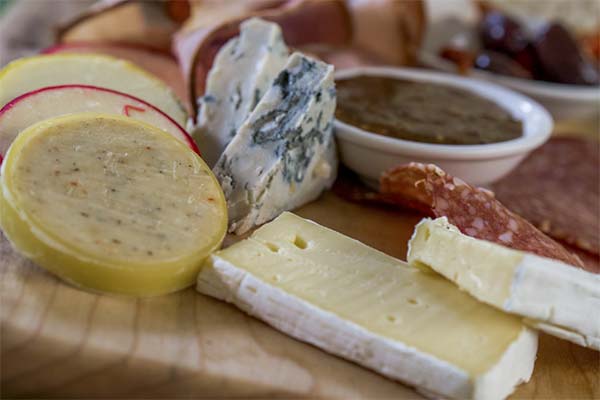
Nabulsi
Camelicious used camel's milk to make their cheese for the first time. The product is white and crustless. A little spice was added to the salty and creamy flavor by sprinkling the cheese head with cumin seeds. The product is used in desserts, fried in oil in a pan, and snacked on alcoholic beverages.
Accavi
This is another type of soft brine cheese which Arabs based on the same camel's milk. Aqqawi is a soft, slightly salty young cheese with a milk flavor. In cooking, it is used to dress pasta and pizza and spread on fresh bread. Mature cheese holds its shape well and is suitable for frying. Served as an appetizer with white wine.
Caravan
Cheese with a light crust of white mold. Compared with a similar product made from cow's milk, this type is sourer. The taste of Caravan is sweet and salty, and the texture of the cheese dough is creamy and elastic. The cheese is added to salads, sandwiches and canapés, served with nuts and fruit. Traditionally, it is served with white dry or red wine.
Kapchgul
A hard, cylindrical cheese made from camel's milk. It is not known for certain where the product was first prepared. The homeland is considered to be one of the Middle Eastern countries. The texture of the cheese head is dense, beige-orange in color. The aroma of the cheese is creamy, the taste is sweet, slightly salty. Arabs eat Kapchgul with nuts and fruit, in sandwiches and canapés.
Camel Milk Chocolate
In addition to having a special gourmet flavor, camel milk chocolate can also be a great alternative to traditional diabetic chocolate. And also a great part of any diet, thanks to the beneficial properties of camel milk!
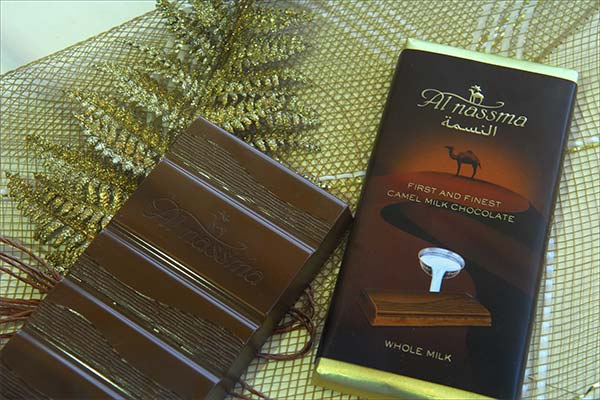
Al Nassma
Al Nassma chocolate is considered the first, but no longer the only chocolate with camel milk. The company was founded in 2008, and the same year it began producing chocolate weighing 70 grams in a variety of flavors: milk chocolate, dark chocolate, Arabian chocolate with a mixture of Arabian spices such as cardamom and cinnamon. Later appeared candies in the form of a camel, a camel caravan, with honey and cream filling, and various types of pralines. Traditionally, a bar of chocolate with camel milk Al Nassma is considered the perfect gift or souvenir for those traveling from Dubai.
Nouq
One of the youngest brands to make pralines in four varieties, using only fresh camel's milk in the process.
Kamelka
Kamelenmelk was inspired to create sweets made of camel's milk by the confectionery company Vermeulen&Den Otter. In 2010 camel's milk candies were produced for the first time. This particular confectionery has an impeccable reputation for confectionery innovation. They are constantly coming up with new products, and it is not for nothing that the confectionery has awards for the best food innovations in the Netherlands. The very idea of using camel milk instead of cow's milk came about in 2009. The candies are sold under the brand Kamelka - which is available in several variants and is currently unrivaled in the Dutch market!
aAdvik
The only Indian company that produces handmade chocolates with camel's milk in three variants. As stated by the producers, these candies will not leave anyone indifferent, as they represent an exquisite elegance.
What can be made with camel milk
Shubat
Shubat is a drink that is traditionally made from camel's milk. The Kazakh name is kymyran, and the Turkmen name is chal. The taste and smell is quite specific. It can be compared to a mixture of ayran and unprocessed sheep milk. The consistency arouses rejection among the unfamiliar people; it is not homogeneous, there are lumps. This sour-milk product is little known; it is impossible to try it in the regions where camels are not herded. To make real chal, you need not only steamed camel milk, but also the hot sun of the desert. The drink is not made for sale, as the shelf life is limited to 24 hours. It can stand for longer in the fridge, but its useful properties are not retained in their entirety.
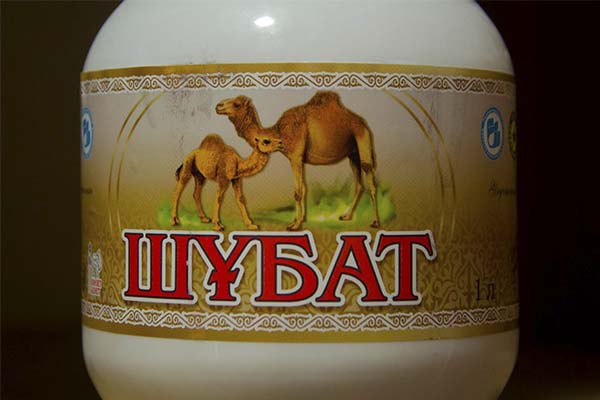
The original raw material for chal is fresh camel's milk. It doesn't even need to be cooled, it's enough to strain it. Its initial temperature is 32 ° C. As a starter use yesterday's drink, lactic acid bacteria cultures, substitutes, sometimes sheep or cow's milk.
Kazakh recipe
Mix the original product with acidified kymyran in the proportion of 1/4-1/3. Pour the liquid into a clay jug in layers: milk, sourdough, milk again. Let stand for 1-2 minutes and mix thoroughly. Shubat should be fermented at a constant temperature of 25-30 ° C, so a container should be placed in the shade and wrapped with a towel, the end of which is dipped in water. After 30 minutes carefully remove the agaran (fermented cream) from the surface. In the future, you can make a variety of desserts, sauces, add to the dough. Leave to ferment the drink for another 3.5 hours. After this time, stir the liquid in a jug every 20 minutes to avoid the formation of large flakes. To get the necessary amount of shubat they add the milk from the next milking. The process takes 6-8 hours, the last refill is done 2 hours before tasting. The first 24 hours the drink is kept in a jug, wrapped in a damp towel in the shade, but on the second day it should be put in the fridge or used as a starter for the next batch.
"City" recipe
In the city, it's impossible to make shubat like in the steppe. There's no one to take yesterday's chal, no conditions-the hot desert sun. The first starter is drugstore lactic acid bacteria, or kefir. Pour 0.5 liters of steamed camel milk into a ceramic container, add 0.125 liters of skim milk powder (cow or camel milk), a few spoons of sourdough. It is left in a warm place. As soon as it begins to separate, the cream is removed. The liquid is stirred every 1-2 hours. After 24 hours the drink is considered ready. It is cooled and stored in the fridge. Once it has overstayed a bit, it provokes diarrhea even in people with the most hardened stomachs. "Urban" chal can be stored for up to 3 days.
Quick recipe
A stockpot is used to make it. They ferment for half an hour in a wooden tub, then remove the agaran. Then pour the liquid into a wineskin and fasten it to the saddle. Camel wanders on steppe and milk is fermented.
Advice! If you plan to quench your thirst, dilute it. But it is possible to combine with water still at preparation, at mixing of initial raw materials, in a proportion 1:1. Water is also heated to a temperature of 32 ° C. This chal is less greasy, tastes softer and nicer, and is more uniform in texture.
Pie
Why not experiment and make a wonderful orange flavored cake with almonds for the whole family? The addition of camel's milk is sure to add some zest to the traditional recipe.
Ingredients (for 8-10 servings):
- 2 fresh oranges;
- 4 tablespoons camel milk;
- 300g of almond flour;
- 6 eggs;
- 100 gr. coconut syrup.
Preparation:
- Fill the oranges with a little water in a saucepan, having previously cut them into four pieces. Cook the oranges over low heat for about 2 hours.
- Preheat the oven to 180 degrees Celsius, line the bottom of the tin with baking paper (approximate diameter 24 cm).
- Beat the eggs with a food processor. Then slowly add the oranges to the eggs. Add the syrup and camel milk, then the almond flour and mix well. Pour the resulting mixture into the mold, level the mass, and bake for about one hour.
Holiday eggnog
During the New Year's holiday season with the family, it will be a great pleasure to experiment in the kitchen and make a wonderful New Year's drink. You will need sugar, camel milk, nutmeg and vanilla. These ingredients can make an incredibly good eggnog that will allow you to enjoy the bliss.
Ingredients:
- 6 egg yolks;
- 1/2 cup sugar;
- 3 cups camel's milk;
- 1/2 tsp. nutmeg;
- 1/4 tsp. vanilla extract;
- pinch of cinnamon;
- pinch of salt.
Step-by-step recipe:
- Whisk egg yolks and sugar together until lightly creamy.
- In a saucepan over medium heat, combine camel milk, nutmeg, and salt. Stir without bringing to a boil.
- Gradually add one tablespoon of the hot camel's milk mixture to the egg mixture, stirring. Once all of the milk mixture has been added to the eggs, pour the resulting mixture back into the saucepan and leave on the stove, stirring constantly without bringing it to a boil. As soon as the mixture begins to thicken, remove it from the heat and add the vanilla.
- Pour the resulting eggnog into a jug or any other container and cover with plastic wrap. Refrigerate. The eggnog will thicken as it cools. If you like a more liquid and delicate consistency of the drink, you can add the cooled mixture to a blender and add 1-2 spoons of cold camel's milk and whip until smooth.
Serve chilled with a pinch of cinnamon.
Muffins
This recipe is for about 12 muffins.
Ingredients:
- butter 150 gr;
- cocoa powder 70 gr;
- 100 gr. bitter chocolate
- flour 300 gr;
- Camel milk 180 ml;
- 6 gr. baking powder
- salt 1 gr;
- Chicken egg 4 pcs;
- sugar 300 gr;
- 100 gr. dates.
Preparation:
- Melt the butter and mix it with the sugar until light. Add the eggs one by one and thoroughly beat the resulting mixture for a few minutes.
- Take another bowl and mix in it the dry ingredients: flour, baking powder, cocoa powder and salt.
- Now mix both of the resulting mixtures together and add the camel milk to them. Stir until you get a homogeneous mass. After that, add pieces of dates and bitter chocolate to the resulting dough.
- Spread the dough into muffin tins and bake in a preheated oven at 180 degrees Celsius for 30 minutes.
Unleavened dough
Camel's milk makes a soft, pliable dough that is easy to roll out.
Ingredients:
- 2 cups. wheat flour;
- 2 eggs;
- ½ cup warm camel's milk;
- 2 tbsp. vegetable oil;
- 1 tsp. salt.
Recipe:
- Mix flour and salt in a bowl.
- In a separate bowl, mix the eggs, camel milk and vegetable oil until smooth.
- Gradually, in small portions, constantly stirring, pour the egg-milk mixture into the flour. The flour should completely absorb the liquid and as a result you should have a homogeneous sticky mass.
- Start kneading this mass with your hands, periodically sprinkling it and your hands with flour. You will obtain a soft, elastic and smooth dough. Roll it into a ball, wrap it in a damp towel and leave it for 15 minutes. When the time is up, sprinkle the table with flour and roll out the dough as thin as possible.
Interesting facts about camel milk
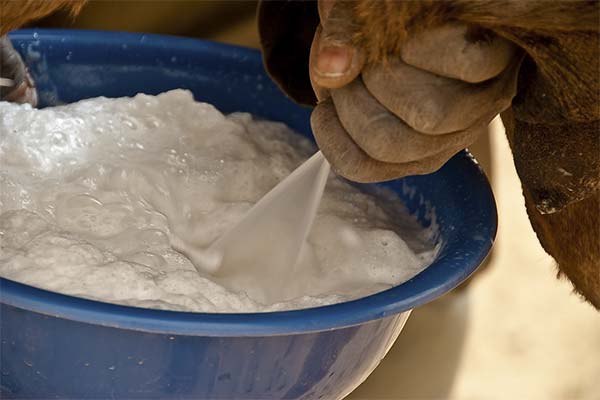
- Camel milk contains antibacterial substances that ensure it stays fresh for a long time, even in hot weather.
- Camel milk is an excellent thirst quencher due to its high sodium content.
- A female dromedary camel produces up to 2,000 kg of milk per year.
- Camel milk contains three times more vitamin C than cow milk.
- A camel must be raised for 4 years before it starts giving milk.
Q&A
How much milk does a camel give?
In East Africa camels give 3.5-4 liters of milk in the dry season and up to 10 liters in the rainy season, which is several times more than cows (0.2 liter and 1 liter respectively). In Kenya, camels produce twice as much milk as cows and nine times more than goats raised under the same conditions.
Why doesn't camel milk sour?
Camel milk is resistant to storage temperature and does not sour longer because it contains many antibacterial compounds, so the number of lacto- and bifidobacteria responsible for souring is small.
Can camel's milk be mixed with alcohol?
The common belief that if you drink a little milk before drinking alcohol, then the alcohol will not enter the bloodstream is incorrect. However, taking milk can reduce intoxication and therefore reduce the risk of alcohol poisoning.
What is cream taken from camel's milk called?
Often in crossword puzzles you can find the question - "what is cream taken from camel's milk called?". Six-letter answer: AGARAN (Turkmen sour-milk drink, fermented cream collected from the surface during the preparation of chal).
«Important: all information on this site is provided for informational purposes only purposes only. Consult with a profile specialist before application of any recommendations. specialist before applying any of the recommendations. Neither the editors nor the authors shall be liable for any possible harm caused by materials."

